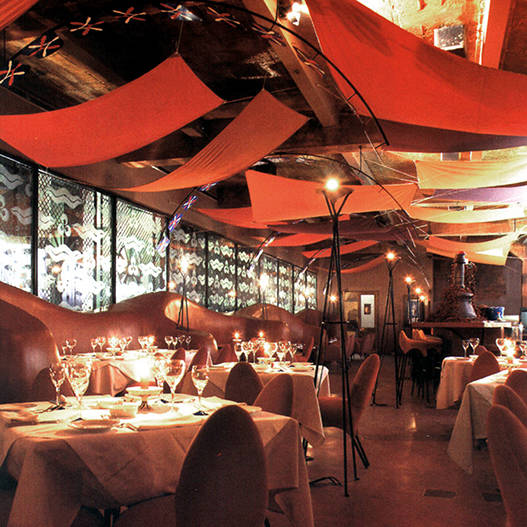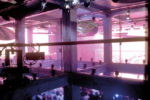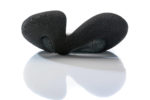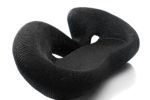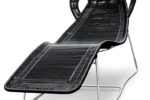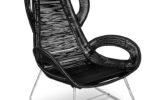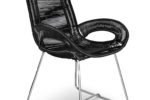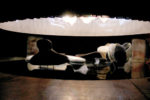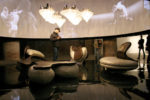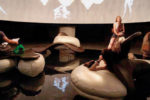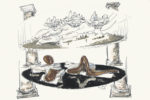Guido Incerti: This issue of Area is dedicated to the theme of leisure and enjoyment: what is your idea of enjoying yourself through your work?
Nigel Coates: I get real pleasure from avoiding the rules of architecture. In the sense that I love the idea of drifting, I feel like a latter day Situationist. Our ability to discover and enjoy the unexpected is a trait we should learn how to use better, especially we architects. Architectural culture is always trying to impose rules when instead it should be able to transport us towards the unexpected. For me, this has been an important lesson. I continue to work on architecture so as to invest it with meaning, and within this, I try to work with our most ludic tendencies.
Margherita Caldi Inchingolo: As a result of new mass media technologies and the internet, how do you think the idea of leisure has changed in recent years?
N.C.: I think that the internet has been positive because it has opened up possibilities of moving around the city…
M.C.I.: But has it not perhaps deprived us of the element of surprise?
N.C.: Not necessarily. In fact in internet language the term “surfing” means wandering, and this is exactly what people do on the net. On the one hand, we have access to an overload of information, and on the other, we have to filter and shape this information according to our own desires. I think that mobile phones and the internet have opened up new possibilities with regard to the city. Things that seem normal to us now, of course weren’t 20 years ago. Now, thanks to mobile phones, people can meet up whenever and wherever they want. Of course there is also the danger of people becoming isolated as a result, of living in a virtual city, even though in theory the choice is theirs. It is interesting to look at how different cultures use technology generally, and in particular, use mobile phones. In Italy you love to chat, see people, meet friends. In other cultures like mine in Britain, some people tend to live more in the “world of the mobile” than in face-to-face situations. Constantly alert to calls and texts, these people avoid being one hundred percent present in any real moment. They are immersed in a fluctuating bubble between physical and virtual space.
M.C.I.: So it’s true that we lose ourselves less easily, don’t explore as much, and as a consequence are less surprised?
N.C.: For me this balance between the real and the virtual opens new way of using the city; this morning, for instance, I left the hotel and after just several paces I got lost, finding myself in an unknown place, at which point I realised I was enjoying the uncertainty of it all. During the night it had snowed, but while I was walking I came across an installation where fake snow had been used. So the fake snow was mixed with the real snow along the road. It was great.
Then minutes later, while passing by the church of Sudario, I saw the Guarini cupola under restoration. The protection panels of the scaffolding were covered with drawn elevations of the building inside them, creating a really surreal effect. Loosing oneself like this helps you understand how cities have changed, and how we have learned to look after them better. Turin, for instance (where the interview took place), has made a tremendous effort to renew itself for the occasion of the Olympics. The result is a prouder city. It’s an organism that’s more aware of its own value, and as a consequence can be lived in to the full. If I think back to years ago, in Italy and in other European cities, generally people used the city less than they do now. There were fewer people in the streets, less activity, less everything, especially in the evening. Today, people are in search of pleasure and naturally this triggers commercial interests to steer the public in certain predetermined directions of benefit to them. As a result, not everyone can, or wants to experience the fantasy of getting lost in cities.
G.I.: As architecture we occasionally get the chance of designing places for leisure, but isn’t there the risk that your designs channel people towards a uniform experience? How can we envisage an architecture of leisure that is open to the imagination of each visitor?
N.C.: A project for a discotheque could raise the level of the experience when it includes characteristics that originate from some other place, for instance the narrative of a house, a city or an airport. Then the occupants can live within a structure that tells a story. A place where the public can only drink or dance is not sufficiently transgressive. The important thing about pleasure is that at least you have the impression that you are breaking the rules. Another example is that of shops: in our commercial world, where people are not only more informed but happy to lose themselves in a consumer universe, shopping is a typical form of leisure. Even at “La Rinascente” in Milan, one of the few examples of department stores in Italy - in England we are more accustomed to entire streets consisting of department stores such as Oxford Street - the concept is nonetheless that of losing oneself within a world of the unexpected: you may have some idea of how departments are organised but the success for the store depends on the people who go one step further than finding the product they set out to buy. The Casinos of Las Vegas apply the same psychological framework, in fact the opposite of that of a simple supermarket which steers the shopper quickly past all the products on offer.
The department store displays everything so as to catch your attention. Of course it applies the art of merchandising, of retail design and an approach to display, but there is also the desire to make the shopper engage in unexpected ways from the very beginning of the experience. Despite the clarity of its guiding pathway, Ikea is a very is a very clever mechanism for literally diverting the shopper. It’s a perfect leisure system. People are guided through the “house” where they see furnished rooms, then a few paces further as if zooming in, they come to a marketplace of products. Finally they arrive in the warehouse, which almost cellar-like, is where products are collected. This home-oriented mega-warehouse changes what could be a simple enough shopping experience into one in which objects inspire the shopper to transform their own space at home. As an architect, a designer and cultural commentator, I have the responsibility of considering each individual on a higher level than that dictated by commercial forces. And this is the architect’s problem: if he or she works for a company, Ikea for instance, the architect must carefully assess the entire spectrum of knowledge we have been talking about. But who should really bear all this in mind? The architect or Ikea? Generally, the architect works on cities, master plans and buildings in order to create places, possible local identities and a territorial culture. Architects find themselves caught in a conflict between large scale purely commercial opportunities to build and their social conscience. They have a huge problem.
M.C.I.: What is the architectural icon that you most associate with the concept of leisure?
N.C.: I don’t think just one icon is sufficient to answer this question. For instance In a building like the museum in Bilbao, the internal space is devised according to the idea of in-built leisure. In fact, Koolhaas interpreted it as a shopping centre. The experiential typology of the Bilbao Guggenheim is this: exploring the differences between galleries, linking the experience of one with the other, and enjoying losing oneself. Although their architecture is more protective, also Tate Modern or the Moma represent an idea of enjoyment that comes from abandoning oneself to more significant experiences. Today, we have learnt how to give people more opportunities to lose themselves. We know how to make individuals believe they have more choice, and this falls within the modern ideology of a society which is none other than a fake world, a world made of mirrors.
G.I.: So the concept of leisure is linked to the idea of losing oneself. On the contrary, however, it would seem that modern technology steers our way of living in a pre-determined way, and no longer permits us to lose ourselves.
N.C.: This is true, but paradoxically, technology provides the individual with the security that enables him to lose himself even more, precisely because we never lose ourselves completely. He is like a child who distances himself from his parents in a public place where the chance to be free seems magnified. But at a certain point he is frightened and starts to cry, leading to the immediate arrival of the parents. He has been found, but for those few moments he experienced the glory of freedom amongst strangers.
M.C.I.: For Nigel Coates is it easier to make playful objects or playful architecture?
N.C.: For me, to be enjoyable both objects and spaces must be intelligent enough to transport you into unexpected worlds. Neither of them can simply be a toy. If I think of all of Alessi’s products, the ones I like the most have a hidden message. Alessi understood that fun is an important feeliing, and not everything has to be serious. Their most successful objects have a hidden message that is discovered over time. Objects and architecture alike are able to touch our child-like sensitivity, that sensitivity we so often try to drive away. Sex for instance is also part of childhood culture. Early on one learns that the exploration of one’s own body raises possibilities for pleasure, communication and seduction. In architecture it is often difficult to reach this level of sensitivity. In the installation I created at the last Venice Biennale I tired to do just that. I worked with seduction, although on a very soft level. Now it is normal to see adverts on passing trams of naked men or women often in provocative poses, but when we get home, within our own walls, we are inexpert at interpreting these signals. We are evolved enough to know what gives us pleasure in the world at large but when we encounter hints of this in our domestic setting, it is hard to accept them. In this respect we live with double values. It is precisely in this field that I work. I try to create frameworks with a degree of comfort, yet nonetheless are able to instil a sense of uncertainty. I make projects that carry us towards a slightly scary world, that touch our subconscious and our will to explore pleasure, that reveal a dizzy universe in which to experiment with the unpredictable. Going back to architecture, the dimension of enjoyment in a building needs to be the result of a hybrid, an ensemble of contradictory forms and images. It must be a threshold that opens countless possibilities. In the 1990s, I designed a nightclub in Istanbul inside a former printing factory: it had 3,000 sq m. on three floors with a restaurant, bar, dance floor, and privé. Most of the effort went on the inside. Behind the original façade, we inserted frosted glazing with a Turkish-inspired pattern, a technique I used throughout the interiors. There were familiar images yet these were destabilizing by their new context: there was a 30-m-long landscape of sofas in a wave with anthropomorphic curves, all made on site by local craftsmen. Then there was a sequence of other spaces, a bazaar with colourful fabric awnings and a dance floor that adopted the language of the airport airside. The airport was always an important metaphor for me. I find airports very amusing places, above all because they suggest how movement can be captured in a space. The deejay booth was set up on one of those goods hoists used to load luggage onto planes. I was looking for a pretext to create a place where visitors could follow their instinct, and in getting lost, could live their own stories. Using the language of airports and at the same time, that of Turkish decorative arts made the club work well for bohemians of all kinds, both local and those visiting Istanbul. I think the project was successful precisely because it created a structure that was invisible from the outside, but which the public discovered little by little. People could invent their own way of behaving within its framework; the architecture captured the mood of the time.
G.I.: If we take your work as a starting point, where architecture is often worn on the body as if it were a suit or an accessory, do you Think that architecture is re-clothing the city in a more seductive form, on the one hand to attract financers, and on the other to give people a good time? Or, making a parallel with those who enjoy shopping, do you think the city tries to raise the pleasure level by wearing new outfits?
N.C.: This is a good metaphor because wearing a garment is to wrap oneself in a very intimate way. However, it is currently an uneasy moment for iconic architecture. We need to work on a more subtle level. Going back to clothing, the metaphor works because it conveys the idea that we can invite people to come into contact with space and approach things without merely judging the objects from afar. If in fact we were to be drawn in, we would be able to discover other worlds. For instance, the world of interiors. Worlds which allow many possibilities, which plays between inside and outside. In fact, the outside can promise all or nothing, as in the case of the club in Istanbul. Once architecture has attracted us, it can lead us into fields of the unexpected. This is its power, and is almost equivalent to the power of religious mysticism. An example which springs to mind is that of the Galla Placidia mausoleum in Ravenna: in the mosaics inside we see a whole new universe, while on the exterior it is only a small, reassuring Romanesque brick building. The unexpected scale of the inside leads naturally, so to speak, to the theatre and in the modern era, to the shopping venue. Both play on the power of seduction to lead us beyond the pure image.
G.I.: The erotic spirit of the city is often cited in your writings and in your urban theories. How does it relate to leisure?
N.C.: The problem is that the city’s erotic spirit has already been assimilated by commercial interests, so we have to continually reinvent the means. We must create contexts which are in the hands of people, and not of institutions, an idea with a “1968 protest movement” twist, which constantly brings into play the importance of narrative. In fact, narrative is a theme on which I worked during the ‘70s and ‘80s, and which gives countless possibilities to our work. Narrative, or better, a narrative tone can help us imagine, design and create places that do not just have convenience value as an ultimate goal. I am looking for something more.
M.C.I.: This year’s Biennale was strongly criticized, even by architects, for the lack of “canonical” architecture. Nevertheless, it was the most visited Biennale. Perhaps its opening up to other artistic disciplines suggests how architecture might move forward.
N.C.: From the outset, we knew that this Biennale would be criticized and that people would say: “Ah, these architects want to be artists”. Personally, I didn’t try to be an artist in the strict sense of the word. But I have to admit that I am driven to use artistic means. It’s instinct that leads me to work this way. In England, we have a class of architecture critics who like concrete boxes, and when they see a Biennale trying to raise the level, they think that architecture is showing signs of self-destruction. These critics are afraid of the city and of taking what it offers. They are afraid of the potential for a city to tune in to people’s sensitivities and real experiences. Going back to the Biennale, in truth, some of the invited architects didn’t try hard enough to make a real impact. They designed something easy. I worked five or six months on Hypnerotosphere (the title of the installation presented at the Biennale), but in the end it seemed to me to be lost inside that “supermarket” of exhibits. On the one hand, we architects are similar, and respect each other as a creative group, but on the other, we feel very distant from one another and tend to be overly self-involved.
What struck me most, and even confused me, was the number of architects who constructed buildings inside the Corderie. The title of the Biennale was “Architecture beyond building” and what did many of the architects, Gehry included, create if not buildings? In exhibitions, architects normally need to see their architecture displayed with maquettes and drawings, and this should be a good enough reason not to do so on this occasion. Aaron did the right thing…


